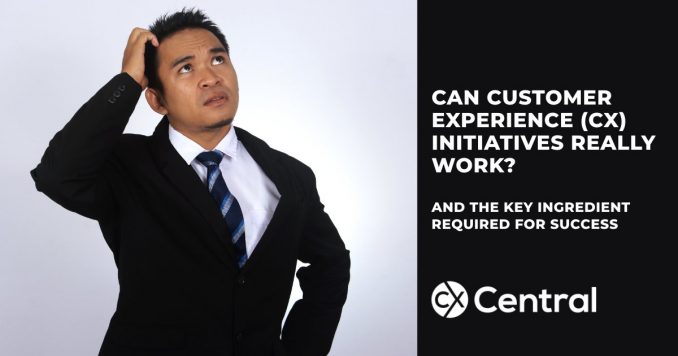
Customer Experience Initiatives – do they really work?
Customer Experience, known in its short form as CX, is everywhere.
Private, public and third sector organisations have all embarked on Customer Experience initiatives with the aim of transforming their services, empowering employees, and optimising their operations.
Why?
Fundamentally, it is because improving the customer experience can improve competitiveness and financial returns for an organisation.
An oft-quoted Forrester Research report states, “a 1% increase in CX 1 scores can translate up to $100 million in annual revenue”.
Despite these compelling reasons for implementing CX initiatives, it seems the theory is not translating into reality for many organisations.
Microsoft commissioned a study of CX projects in Australian financial services.
In their findings, they found “More than four out of five (81 per cent) of financial organisations have 2 had failed customer experience projects.”
This is an incredibly high risk and poor return on the significant investment involved in CX initiatives.
The question, therefore, becomes, given the great benefits of Customer Experience initiatives, is there a way of ensuring their success?
Certainly, there is plenty of advice available.
The CX Initiatives Must’Do’s
Indeed, you may have heard some of these ‘must do’s’ before:
- Create a dedicated customer-driven CX team
- Focus on delighting your customers and continually listen to your customers to obtain insights
- Prioritise work on customer value from a backlog of ideas
- Ensure you map the end-to-end customer journey and remove pain points
- Break down silos across the organisation; create small cross-functional empowered and autonomous teams
- Create a safe to fail culture
- Be outcome driven; measure customer value and link back to business value
- Ensure single ownership of the CX initiative instil a CX culture
All these recommendations sound great; however, the challenge is converting these words into actions that will be embraced by the people who have to implement and work with the changes to their well-established working patterns.
Every day.
Why many CX Initiatives are failing
Not surprisingly, the commonly adopted ‘do it to people’ approach to CX initiatives ends in concerted resistance within the organisation and is seen as a lamentable failure by its leaders.
Why?
Because initiatives that threaten current organisational beliefs and mindsets that typically underpin any organisation, are simply resisted until the initiatives are pronounced a mistake, a failure or a complete waste of time and money.
Today’s CX initiatives do not incorporate effective theory and methods required to help to influence and create a shift in organisational behaviour and leadership capability.
They lack the practical method required to solve core organisational issues: control from above; negative mythologies underpinning culture; stultifying systems and structure; quality of leadership; negative team behaviour; lack of clarity in their role; accountability, authority; and working relationships.
The reason Customer Experience initiatives fall short is the lack of sound underpinning sound theory that addresses why people behave as they do and how to build an organisation that enables colleagues to work productively to service customers.
Through the lack of a practical method to solve core issues along with an absence of real knowledge and testable theory, potential benefits are predictably constrained and often not realised at all.
The Modern Leader’s Approach
Progressive leaders question the efficacy of today’s CX initiatives.
They recognise that creating a shift in organisational behaviour and leadership capability is a critical and fundamental part of the process in positioning the organisation and all who work within it, to adopt better CX paradigms that will succeed in the digital age.
To unlock the profound benefits of improved customer and employee experience, progressive leaders understand the need to help people reconceive the way in which their work is designed, organised, and led.
Through the application of a different philosophy, where the context for improvement is driven by what creates value for customers and how best to service them; people are organised and enabled to do that work more effectively; productive leadership practices are embedded; and the resulting positive behaviour and culture will be sustained.
That is a successful CX initiative.
Further reading and support:
- Read: How to build a customer-centric organisation
- Read: 4 Common CX failures made by businesses
- Upskill: Search our courses on Customer Experience Management
- Search: Industry Consultants who specialise in Customer Experience (CX)
1Forrester’s Customer Experience Index Online Survey, US Consumers Q1 2015
2Microsoft urges financial services firms to tackle data blindspots to reduce risk of costly failed CX projects

